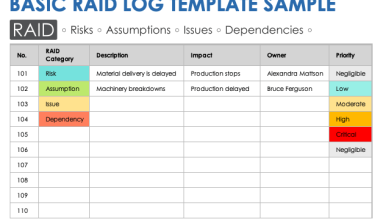Companies launch new projects every single day and invest thousands of dollars, hours, sweat and tears into their success. And yet just about every one of us has encountered a project that did not successfully complete.
Why is it so hard to meet and manage the expectations of project stakeholders? In this article we are going to identify some of the best ways to ensure the projects you are responsible for are the most successful projects possible!
1. Setting realistic expectations
One of the very first things that you can do to help ensure the success of your project is to set realistic expectations up front. This means that all stakeholders need to be clear on exactly what a successful outcome looks like with this project and that the scope is clearly defined. So why do people struggle at this step? I think there are a few reasons.
Who is setting the expectations?
When it is our executives who are setting the expectations, they may be setting the bar higher than is realistic, and it is up to you as a project manager (or perhaps as a member of the committee discussing the project) to help align those expectations with reality. If an executive sets an unrealistic volume of work or an unrealistic date, you need to be prepared with facts to push back on those demands. Be prepared with all the backup data you need to support your perspective. You might look at past projects, the physical number of manhours available versus required for project completion, the average cost of similar projects versus the current project budget and so on.
This then begins a negotiation process. If the project must be done with the original parameters, what will be needed? Does the team need to have more people? More money? More resources such as contract labor or rented equipment or new tools? By approaching the situation as a team effort to ensure success, rather than an adversarial perspective of “us versus them” you can brainstorm ideas for how to help the project come to fruition.
Is there clarity needed on the scope of the project?
Identifying the full scope of the project is one of the most challenging aspects of managing a project. For new project managers, one of the primary issues is that you literally don’t know what you don’t know. You may be making assumptions without even realizing it. You may not be fully cognizant of the impact of requests or changes that you are making and the domino effect those requests may have on remaining steps in the project.
As an example, if you were responsible for hiring a painter to complete a painting project, you might not be aware of what is typically included or not included in that contract. You might assume that asking a painter to “paint a room” would include everything in that room once you have walked in the door. For most painters, you would probably be wrong. Examples of what might NOT be included in a typical painter’s contract would be: the ceilings, the trim/baseboards, the closets, removing things from the wall, applying primer, what quality of paint, etc. All of these additional elements might increase the cost of the quote and the time of completion of the project.
Once you have hired a painter a few times, you become more familiar with how they work and what is included versus not, and your requests for proposals (quotes) will become more specific. But you might go through some rough initial projects learning the hard way how to properly define a scope. While a good reliable vendor should help you to avoid making assumptions by clearly spelling out all the details in their quote, they may also be making assumptions about your level of experience and knowledge and you knowing what you want.
You can enhance your knowledge by learning the right questions to ask. You will of course customize your questions depending on the situation and project, but here are some examples you could start with.
When first learning about a project:
- Have we done a similar project previously and how did that turn out?
- What exactly is included in this project scope? (For example, do you want our committee to do research and provide recommendations on a new software or do you want us to purchase that software and implement it?)
- What do you foresee being the deliverables when we are complete?
- How will we decide who is working on this project? Who are the “right people” to work on this project?
- What is our budget and what does that include?
- How were the project deadlines chosen? What is driving date and dollar decisions?
- What are the anticipated milestones?
When getting quotes from vendors:
- What exactly does this quote include? Does it include materials, labor, taxes, fees, payment methods, payment terms, deliverable dates, etc.?
- What does this quote NOT include?
- Is there anything you think I should be considering when making my decision?
- What other products or services might I want to consider adding and why?
- What extra charges might be added in the future?
- What would impact the schedule or cost of this project?
- Do you have any suggestions for how we could do this more efficiently or cost-effectively?
- How much cushion is built into this schedule to allow for future minor issues?
Even the best laid plans can fall apart at times. Not everything is within your control. Part of managing expectations is taking the time initially to have a good understanding of what needs to be done in the project. Ask yourself at the beginning – what do I know and what do I NOT know about this overall process? Who has a better understanding of this type of project that I could reach out to for guidance? How can I learn more about what I do and don’t know?
2. Avoiding issues through a good change management process
Change happens in every project. Change alone is not necessarily good or bad. It simply is. However, having a poor change management process almost inevitably leads to future problems. The most common issue is that a change is made verbally and doesn’t get communicated to everyone who needs to know or a change is made verbally but key parties forget that the change was discussed and agreed to.
One of the key ways you can prevent issues in your project is to have a clear change management process that is followed faithfully, no exceptions. For example, you might require that all changes are in writing and must be approved by certain individuals within the project, no matter how minor.
The challenge of a process of this nature is that it can tremendously slow down the process waiting for approvals. When people get impatient, they tend to take shortcuts. Instead, you might choose to have changes over a certain monetary amount in writing and approved. You can identify where you want guidelines to fall, but having specific procedures that are clear to all will help to avoid issues that commonly arise of “he said/she said” when there is nothing in writing to support either side.
3. Recognizing trouble on the horizon
You may not have enough experience to recognize when a task is taking longer than it should or when there are looming issues. Careful tracking can help you to discover issues while they are still small enough to address without impacting the schedule.
Every task within your project (your work breakdown structure document) should have an associated start and completion date and a person assigned to be responsible for it. Sharing timely feedback on progress with the entire team will help everyone watch out for issues that may have a domino effect (such as a delay in a permit preventing construction groundbreaking from happening).
Using the tools at your disposal (Gantt charts, spreadsheets, notifications, shared collaboration tools such as Slack or Trello, etc.) can help to keep the team fully apprised of approaching issues.
This is also where the classic expression of “trust, but verify” comes in. You cannot assume that people are doing what they say they are doing. Unfortunately, there will always be that one vendor out there that says something is going fine because they don’t want to admit that mistakes were made or something has gone awry. You need to set up procedures and internal controls to review and inspect work to ensure it is getting done as it is said to be getting done. The advantage of doing this is that if something is wrong or doesn’t match the quoted scope (such as with a simple oversight), it’s often much easier to make immediate corrections. If you wait until later, the corrections may involve additional work, such as when fixing an electrical mistake results in needing drywall repairs and repainting too. Mistakes can become exponentially more expensive if they are not caught early.
4. Communicating issues effectively
If you do identify an issue that is going to impact the schedule or cost of the project, you need to have an immediate discussion with all stakeholders, particularly anyone from upper management who might need to approve the additional costs or changes. This can be a challenging conversation. It is never pleasant being the bearer of bad news, but delaying it will only make it worse, and honestly, conversations often go much worse in our head when we are dreading having them than they do when we actually physically have them.
Before starting that conversation, try to have as much information as you can about what has happened, why, what the impact is on the project and what options are available to solve or address the issue. Lay it all out there. Be honest about the impact – negative and positive.
Don’t be too quick to “throw yourself on your sword”. As administrative professionals, it is sometimes almost in our DNA to step in and take responsibility for things even when they aren’t specifically a result of our actions. If it is your fault, then absolutely take responsibility, acknowledge the mistakes made, and state that you will do everything in your power to make it right. If it isn’t your fault, just focus on what has happened and what the options are for addressing it. Keep emotions out of it as much as you can and just stay focused on the facts and actions needed.
Once the issue has been discussed and a solution chosen, implement it immediately, following the change management process. Be sure to incorporate notes about the entire issue into your debriefing process (see next step).
5. Learning lessons to avoid repeat problems
While debriefing meetings are often held following any project completion and many lessons are indeed learned, studies have shown that when it comes to time management, people rarely apply the lessons learned to future projects. Instead, they assume that their projections of cost or time needed were accurate previously, but that outside forces caused delays or increases that would not happen again in the future.
As a result, people tend to make the same mistakes repeatedly when estimating the length of time needed for tasks or project costs. Because they aren’t applying what they have experienced to future projections, this will often translate to projects that are repeatedly running late or over budget.
In order to effectively manage customer expectations of your project, you must start by managing your own expectations and estimations. Pay attention to how long you estimated something would take or how much something would cost versus how long it did take or how much it did cost when the time came. Then, rather than assuming there were outside factors that will not repeat, assume that those revised estimates were what you should have started with. Over time, you will start to have a much better expectation of what is realistic and you will be able to communicate those expectations to all stakeholders.
6. Finishing triumphantly
It is easy to focus on the negatives of our journeys. At the end of the project, we might be so caught up in thinking about all the things that went wrong that we don’t stop to appreciate the things that went right. Managing customer expectations also means redirecting their attention and focus to the positive results of your projects and not allowing them to only focus on the negative.
By incorporating these steps into your project management process, you will find a much higher level of success in managing the expectations of everyone involved in the project.
As more people work with you and discover that you act with forethought and integrity, they will be much more inclined to add you to their project teams in the future. This will lead to higher profile projects where your company recognizes the value of your contributions. Being involved with projects in your company, particularly those that expose you to individuals you might not have worked with previously, can allow you to develop a positive reputation that will advance your career over time.






